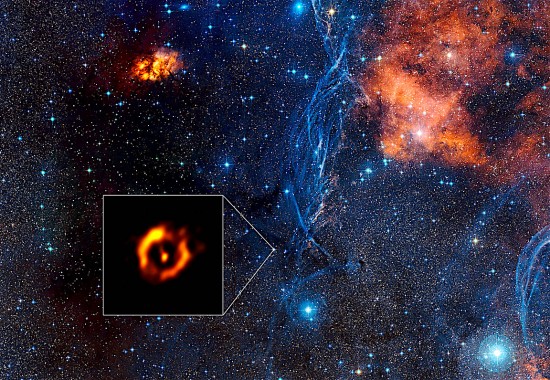
Double star IRAS 08544-4431’s disk. Credit: ESO/Digitized Sky Survey 2. Acknowledgement: Davide De Martin
Mar 9, 2106
It is not possible to tell if stars are old or young based on their colors or temperatures.
A recent press release from the European Southern observatory (ESO) reports that double star IRAS 08544-4431 is surrounded by a dusty disk. What makes the discovery so unique is that young stars are normally associated with disks of ionized matter.
Conventional theories assume that many stars can eject disks of gas and dust that then surround them with a halo. The assumption is that the material is expelled by their equivalent to the solar wind. According to the press release, the structure around IRAS 08544-4431 looks like the disks that form so-called “protoplanetary nebulae” around what are thought to be young stars.
In general, astronomers do not know how stars “throw off gas and dust” because neither nebulae nor stars are composed of “gas”. Gas behaves according to the laws of kinetics, whereas stars and nebulae are composed of plasma, which behaves according to the laws governing electrical discharges and electric circuits.
A star, as written elsewhere, is the locus of electric charges that circulate through the galaxy along star-spanning filaments known as Birkeland currents. A red giant, as is the second star in the IRAS 08544-4431 pair, lacks a photosphere, or the radiative “surface” that emits radiation, so its chromosphere has expanded in order to meet the red giant’s electrical needs.
The electromagnetic “z-pinch effect” that squeezes plasma into a star also forms a toroidal current around the star’s equator. Increasing flux density causes the plasma to glow. In an Electric Universe, an explanation for the binary star’s “expulsion disk” is not related to the star’s age or to gravitational fields: the ring is a barrel. The view is almost down the axis of an hourglass-shaped plasma structure.
As Birkeland currents expand away from a z-pinch, current density decreases and the glow falls off. The Very Large Telescope Interferometer is sensitive enough to see it, revealing the shape of the filamentary network in a roughly circular arrangement of bright spots at the ends of dimmer filaments. Plasma filaments do continue trailing away from the bright regions, but the plasma density is so low that they are in “dark mode” and no longer glow.
It is important to remember what retired Professor of Electrical Engineering, Dr. Donald Scott wrote:
“In the Electric Star model, perhaps the most important factor in determining any given star’s characteristics is the strength of the current density in Amperes per square meter (A/m^2) measured at that star’s surface. If a star’s incoming current density increases, the arc discharges on its surface (photospheric tufts) will get hotter, change color (away from red, toward blue), and get brighter. The absolute brightness of a star, therefore, depends on two things: the strength of the current density impinging into its surface, and the star’s size (the star’s diameter). Therefore, we add another scale to the horizontal axis of the HR [Hertzsprung-Russell] diagram: Current Density at the Star’s Surface.”
The disks surrounding “young” stars are not due to gravitational accretion, they are due to electromagnetic expulsion, just as the ones around “old” stars.
Stephen Smith












